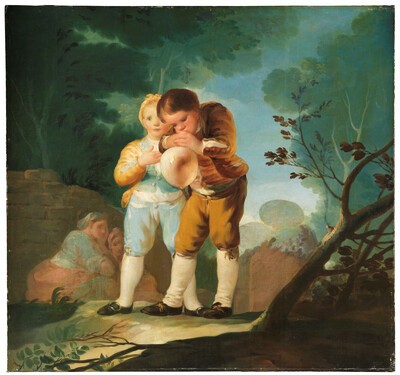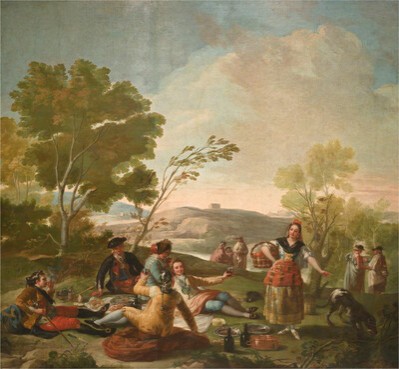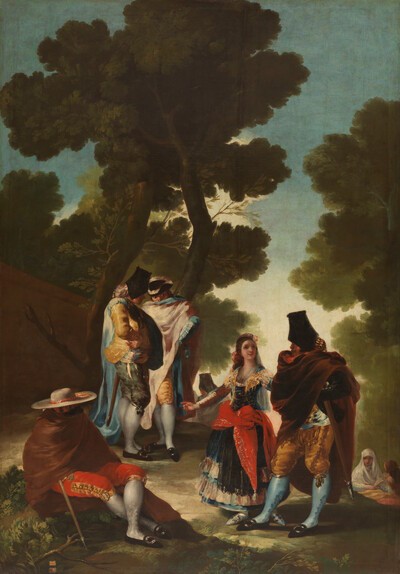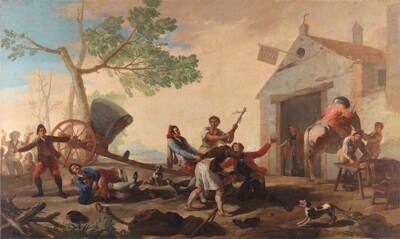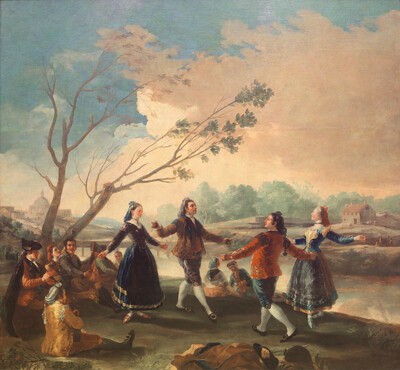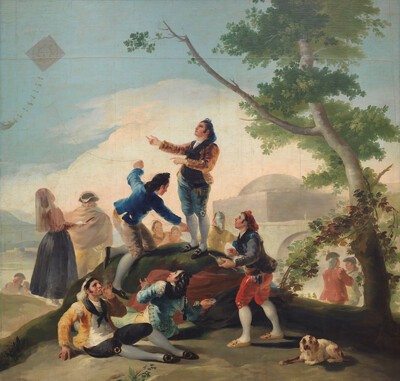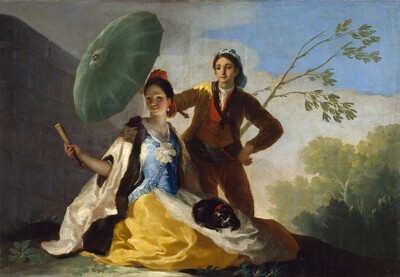- Cronología
- 1777
- Ubicación
- The Prado National Museum. Madrid, Madrid, Spain
- Dimensiones
- 107 x 151 cm
- Técnica y soporte
- Oil on canvas
- Reconocimiento de la autoría de Goya
- Documented work
- Titular
- El Prado National Museum
- Ficha: realización/revisión
- 18 Nov 2009 / 14 Jun 2023
- Inventario
- (P00772)
The Drinker formed a pair with The Parasol; the tapestries resulting from these cartoons were designed to be hung over the doors on the east side of the dining room.
Executed with a low perspective, taking into account its elevated position above the door, this cartoon shows the main figure drinking from a Catalan wineskin, a detail specified by Goya on the invoice. Next to him sits another young man and behind are three figures who appear to have been included to compensate for the unsteady, greedy drinker, whose silhouette stands out against the blue sky behind. The composition as a whole fits a pyramid structure, with the artist thus distancing himself from the influence of Francisco Bayeu. This work is also of Goya's own invention, as he assures in the paperwork delivered to the Royal Tapestry Factory.
According to Tomlinson's interpretation, who saw in this series of cartoons a moralistic meaning relating to the seven deadly sins, this particular work would represent the sin of gluttony.
The same author also believed that Goya may have taken his inspiration for this piece from the novel El lazarillo de Tormes, which was extremely popular in Spain at the time. We can see a cane, which would allude to the blindness of the drinker, whose gaze is lost in the middle distance, and the young man at his side would be the character of the lazarillo, the blind man's guide, who, with a look of resignation on his face, is eating his simple meal (bread and turnips, as seen in the still life in the foreground) whilst the blind man finishes off the wine without stopping to share any with his companion.
-
De El Greco a GoyaPalacio de Bellas ArtesMexico D.F.1978November-December 1978pág. 132
-
Panorama de la pintura española desde los Reyes Católicos a GoyaPalacio del Concejo DeliberanteBuenos Aires1980organized by Ministerio de Cultura de Españapág. 132
-
GoyaNationalmuseumStockholm1994consultant editors Juan J. Luna and Görel Cavalli-Björkman. From October 7th 1994 to January 8th 1995cat. 3
-
Goya. 250 AniversarioMuseo Nacional del PradoMadrid1996consultant editor Juan J. Luna. From March 29th to June 2nd 1996cat. 11
-
Goya en Madrid. Cartones para tapices 1775-1794Museo Nacional del PradoMadrid2014p. 109
-
L'œuvre peint de Goya. 4 volsParís1928-1950vol. I, p. 64, cat. 5
-
Tapices de GoyaMadridPatrimonio Nacional1946pp. 97, 101, 210, cat. 14 y láms. 66-67
-
Vie et ouvre de Francisco de GoyaParísOffice du livre1970pp. 75, 86, cat. 79
-
BarcelonaPolígrafa1970vol. I, p. 245, cat. 68
-
L’opera pittorica completa di GoyaMilanRizzoli1974pp. 94-95, cat. 74
-
Francisco de Goya, 4 vols.ZaragozaCaja de Ahorros de Zaragoza, Aragón y Rioja1980-1982vol. I, pp. 86-87 y p. 116 (il.)
-
Francisco de Goya, cartones y tapicescol. col. "Espasa Arte"Espasa Calpe1987pp. 80, 77-78, 152, 190, 256, cat. 18C
-
Imagen de GoyaMadridLumen1983p. 69
-
Francisco de Goya. Los cartones para tapices y los comienzos de su carrera en la corte de Madridcol. col. "Ensayos de Arte Cátedra"MadridCátedra1987pp. 70-72, 89 y p. 71 (il.)
-
Goya. 250 AniversarioMadridMuseo del Prado1996p. 280, cat. 11 y p. 66 (il.)
-
Salas del Palacio Real de El Pardo para las que se tejieron tapices sobre cartones de Francisco de Goya: identificación de las habitaciones y ajuste de las obras de Goya en los alzados de las paredesin HERRERO CARRETERO, Concha (curator, Tapices y cartones de Goya (catalogue of the exhibition organizated at the Palacio Real de Madrid, from may to june 1996)MadridPatrimonio Nacional, Goya 96, Lunwerg1996p. 167 (il.)
-
Goya en Madrid. Cartones para tapices 1775-1794MadridMuseo Nacional del Prado2014p. 109

